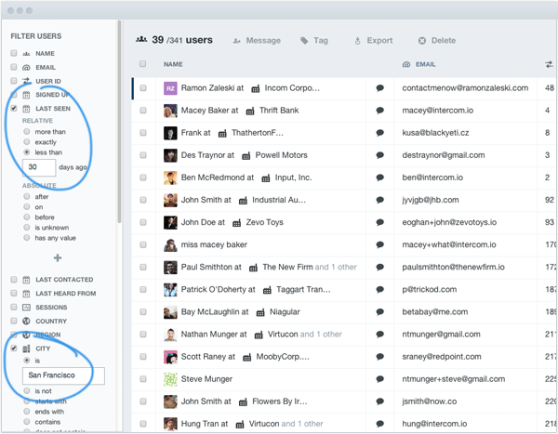Ever since the dawn of digital communications, marketers have faced the same problem time and time again. How do you quickly, easily and effectively segment your data and send a message to your clients — via email or within your app — without having to involve engineers, developers, and other teams in the process?
Intercom, an online platform that allows companies to see who is using their product and deliver personalized messages to their customers, announced a new feature today to try solve that problem for good.
 “Mass marketing – blasting the same message to everyone – is dead,” Eoghan McCabe, co-founder and CEO at Intercom, told me via email. “We’ve entered an age of personalization, where businesses can leverage user data to send the right message to the right person at the right time.”
“Mass marketing – blasting the same message to everyone – is dead,” Eoghan McCabe, co-founder and CEO at Intercom, told me via email. “We’ve entered an age of personalization, where businesses can leverage user data to send the right message to the right person at the right time.”
Personalization, of course, has not traditionally been easy.
Marketers have quite the task ahead of them if they want to create customer segments in order to broadcast important and timely messages, especially if they want those communications to feel personalized and individual to the client. For example, let’s say you’re running a seminar at a local hotel and you want to invite everyone that is within a certain distance of the location. Or maybe you want a segment of all customers that haven’t been contacted within a certain timeframe.
Your first stop might be to work with the engineers, CRM team or database administrators to create a list of contacts that fit the bill. You might then need to work with your developers to deliver a message in-app to everyone in that segment, and then spend time uploading the data to MailChimp or some other email marketing platform.
Eventually, you’re ready to deliver the message. Hopefully you thought ahead and built some tracking in to your chosen delivery system so that you know who opened the message, who opted out of communications after seeing it, and who acted upon it. And hopefully it hasn’t taken so long your campaign is already over.
Intercom says it has solved this problem.
“Marketers can independently segment their audience and send messages without getting bottlenecked,” McCabe told me. “They can get their messages out on time.”
We’re studying free-or-cheap marketing automation systems.
Add your voice, and we’ll share the data with you.
Here’s how it works:
SaaS businesses install Intercom by placing a snippet of JavaScript within their app. The system then starts recording customer information, behavioral data (such as how often they use the product, which features they use etc.), plus details such as client location, the payment plan they’re on and more.
Within Intercom’s new interface, it is then possible to quickly and easily create segments based on this data.
For example, it takes just two clicks and a few keystrokes to create a split of customers that are in San Francisco and that have used the product within the last 30 days. Once the target segment is created, Intercom users can then choose how to communicate with those contacts. The new features allows you to deliver messages within your app or via email using a simple message builder that makes it easy to add graphics, links, buttons and more, within seconds.
In-app messages are particularly powerful, according to Intercom.
They claim that messages sent to customers within the user’s app are up to ten times more engaging than email. Importantly, both in-app and email communications are two-way and appear as if delivered by a person — no messages from the ‘Customer Service Team’ or ‘do-not-reply’ email addresses that stop a conversation in its tracks.
Email messages from the system are delivered through Intercom.
Of course, there are a huge number of email service providers (ESPs) available, so I asked why the company didn’t partner with one or more of those solutions instead?
“Intercom is an integrated platform,” McCabe explains. “Everything works better when workflows and data are seamlessly connected: live user data, communications, and conversations all in one place. We’ll provide integrations with established outside providers where appropriate — for example we just released a Salesforce integration — but we didn’t see anything in established ESPs that we couldn’t improve by building it within Intercom,” McCabe concludes.
Intercom’s new segmenting and messaging features are available today. Pricing starts at $49 per month and all plans include email and in-app messaging.
VentureBeat's mission is to be a digital town square for technical decision-makers to gain knowledge about transformative enterprise technology and transact. Learn More


